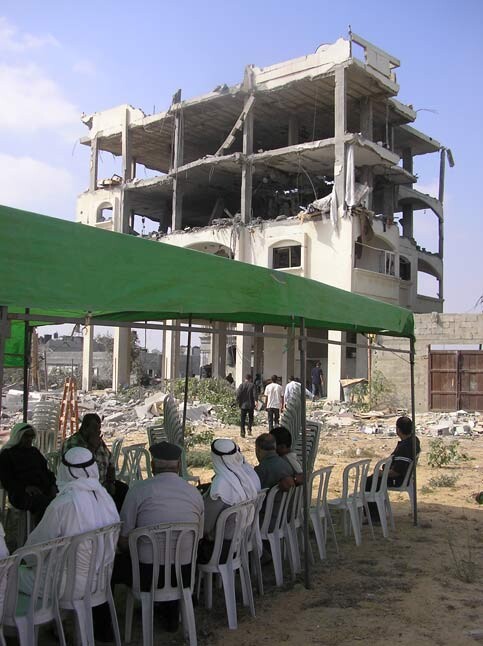IRIN 11 December 2006

A building destroyed by an Israeli air strike in Beit Lahiya, Gaza. (Tom Spender/IRIN)
The F-16 fighters and Apache gunships may now be absent from the Gaza skies - but that doesn’t help Omar Mohammed Mamlouk and his 18-strong family, living in a tent amid the rubble of their home.
The family fled their house in Gaza City’s Yarmouk Street after Mamlouk was called on his mobile by the Israeli military, an officer telling him a missile strike was to be launched on his house.
“That phone call haunts me - I think about it 24 hours a day. We are now in the street. We have no shelter. I don’t know where are the human rights organisations or whether they can help us,” he told IRIN.
“I had nothing in this life except my house. I lived for a while with my brothers, but their houses are small and I don’t have the money to rent.”
The Israeli military destroyed 251 homes in Gaza between July and November 15 this year, leaving 1,577 people homeless, according to the Israeli human rights organisation B’tselem.
In 105 of these cases the IDF destroyed the home by airstrike after warning the inhabitants to leave.
Israel says that before a ceasefire came into effect on 26 November it targeted the homes of militants and homes that are used to store weapons.
“The Israeli Defence Force (IDF) only targets terror activity and infrastructure which is used against Israeli citizens. The IDF has no intention of harming uninvolved civilians,” said a spokesman for the Israeli military.
But the Israeli human rights group B’tselem said the IDF had not produced hard evidence in individual cases to support its claims.
“Demolishing homes as punishment or retribution is expressly forbidden in international law - but it’s very hard to know in individual cases what happened because Israel does not provide much information and no one is holding them accountable for it,” said B’tselem spokeswoman Sarit Michaeli.
She said Israel had to prove homes were a legitimate military target before striking them.
“The fact that there are militants in a house does not necessarily make that house a legitimate military object.
However, if the house is being used for military purposes then it is not immune to attack,” she said, adding that any attack must distinguish between civilians and fighters and be proportionate to be on the right side of international human rights law.
The big families who are left homeless must rent a place if they can afford it, move in with relatives in incredibly cramped conditions or else eke out a dusty living on the street.
“I never thought we would end up in a tent after we were living in big and comfortable house. I feel shame to go to my school and see my friends,” said Suhair, Mamlouk’s eldest daughter, aged 17.
All the owners of homes destroyed by the Israeli military that IRIN spoke to in Gaza said they had no chance to take their belongings from their houses before they were destroyed.
“The Israelis told us we had 30 minutes - but we have seen in other places in Gaza they destroy the homes in less time than they say they will give you. You cannot know when they will strike so we just had to leave everything and run,” said Mamlouk.
Sheikh al-Deeb, originally from the Nasser area of Gaza City, and the 45 members of his extended family are not on the street - instead they are living in one room in his parents’s home.
“We have no freedom. We are packed in like boxes of tomatoes so we can barely move, especially at night. There is no space at all between us. It means we can no longer be individuals,” he said.
The demolition of homes has also caused panic attacks among Gaza residents who fear that they may be left without a roof over their heads at any time, Majda Hassan, 33, from Tal Zaatar told IRIN.
“I answered the phone once and it was an Israeli. I lost my mind immediately. I ran and told my husband the Israelis wanted to destroy our flat - everything we have is here. It turned out it was a propaganda call with an Israeli officer asking us not to support the fighters. It was a shock,” she said.
Majda still has a roof over her head - but Mamlouk, a Bedouin, said he had been bombed back to the age of his ancestors.
“Look at us,” he said.
“We are living just like our forefathers 100 years ago.”
This item comes to you via IRIN, a UN humanitarian news and information service, but may not necessarily reflect the views of the United Nations or its agencies. All IRIN material may be reposted or reprinted free-of-charge; refer to the copyright page for conditions of use. IRIN is a project of the UN Office for the Coordination of Humanitarian Affairs.
Related Links